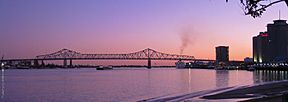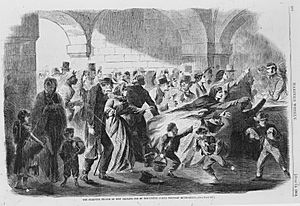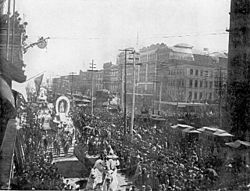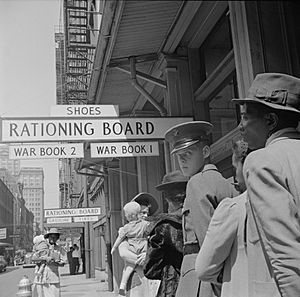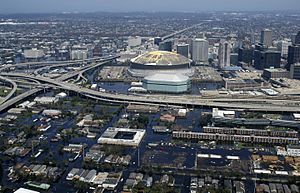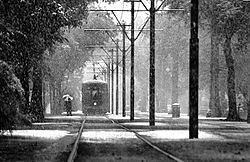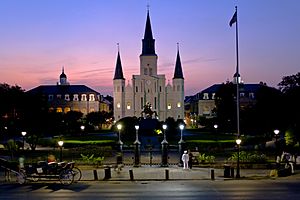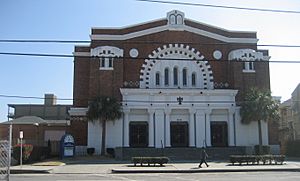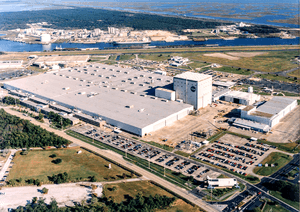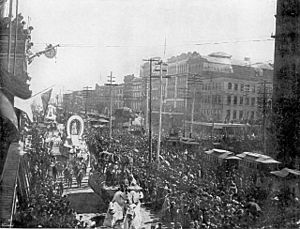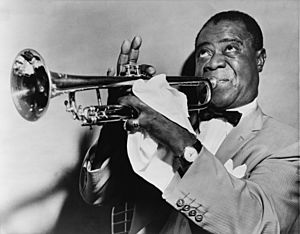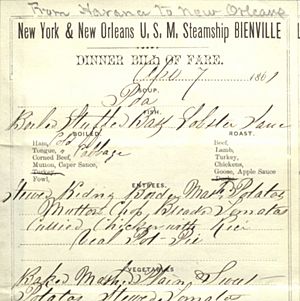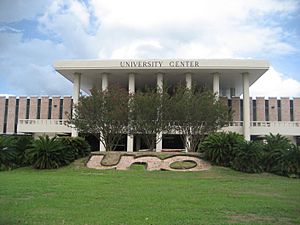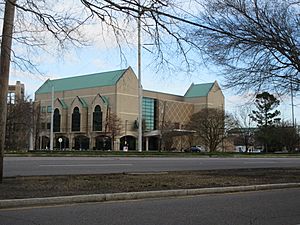New Orleans facts for kids
Quick facts for kids
New Orleans
La Nouvelle-Orléans (French)
Nouvèl Orleans (Louisiana Creole) |
|||||
|---|---|---|---|---|---|
|
Consolidated city-parish
|
|||||
|
University of New Orleans
Crescent City Connection
|
|||||
|
|||||
| Nicknames:
"The Crescent City", "The Big Easy", "The City That Care Forgot", "NOLA", "The City of Yes", "Hollywood South", "The Creole City"
|
|||||
| Country | United States | ||||
| State | Louisiana | ||||
| Parish | Orleans (coterminous) | ||||
| Founded | 1718 | ||||
| Founded by | Jean-Baptiste Le Moyne de Bienville | ||||
| Named for | Philippe II, Duke of Orléans (1674–1723) | ||||
| Government | |||||
| • Type | Mayor–council | ||||
| Area | |||||
| • Consolidated city-parish | 349.85 sq mi (906.10 km2) | ||||
| • Land | 169.42 sq mi (438.80 km2) | ||||
| • Water | 180.43 sq mi (467.30 km2) | ||||
| • Metro | 3,755.2 sq mi (9,726.6 km2) | ||||
| Elevation | −6.5 to 20 ft (−2 to 6 m) | ||||
| Population
(2020)
|
|||||
| • Consolidated city-parish | 383,997 | ||||
| • Density | 2,267/sq mi (875/km2) | ||||
| • Urban | 963,212 (US: 49th) | ||||
| • Urban density | 3,563.8/sq mi (1,376.0/km2) | ||||
| • Metro | 1,270,530 (US: 45th) | ||||
| Demonym(s) | New Orleanian | ||||
| GDP | |||||
| • Consolidated city-parish | .482 billion (2023) | ||||
| • Metro | 2.437 billion (2023) | ||||
| Time zone | UTC−6 (CST) | ||||
| • Summer (DST) | UTC−5 (CDT) | ||||
| Area code(s) | 504 | ||||
| FIPS code | 22-55000 | ||||
| GNIS feature ID | 1629985 | ||||
New Orleans (commonly known as NOLA or The Big Easy among other nicknames) is a consolidated city-parish located along the Mississippi River in the southeastern region of the U.S. state of Louisiana. With a population of 383,997 according to the 2020 U.S. census, it is the most populous city in Louisiana and the French Louisiana region; the third-most populous city in the Deep South; and the twelfth-most populous city in the southeastern United States. Serving as a major port, New Orleans is considered an economic and commercial hub for the broader Gulf Coast region of the United States.
New Orleans is world-renowned for its distinctive music, Creole cuisine, unique dialects, and its annual celebrations and festivals, most notably Mardi Gras. The historic heart of the city is the French Quarter, known for its French and Spanish Creole architecture and vibrant nightlife along Bourbon Street. The city has been described as the "most unique" in the United States, owing in large part to its cross-cultural and multilingual heritage. Additionally, New Orleans has increasingly been known as "Hollywood South" due to its prominent role in the film industry and in pop culture.
Founded in 1718 by French colonists, New Orleans was once the territorial capital of French Louisiana before becoming part of the United States in the Louisiana Purchase of 1803. New Orleans in 1840 was the third most populous city in the United States, and it was the largest city in the American South from the Antebellum era until after World War II. The city has historically been very vulnerable to flooding, due to its high rainfall, low lying elevation, poor natural drainage, and proximity to multiple bodies of water. State and federal authorities have installed a complex system of levees and drainage pumps in an effort to protect the city.
New Orleans was severely affected by Hurricane Katrina in late August 2005, which flooded more than 80% of the city, killed more than 1,800 people, and displaced thousands of residents, causing a population decline of over 50%. Since Katrina, major redevelopment efforts have led to a rebound in the city's population. Concerns have been expressed about gentrification, new residents buying property in formerly close-knit communities, and displacement of longtime residents. Additionally, high rates of violent crime continue to plague the city with New Orleans experiencing 280 murders in 2022, resulting in the highest per capita homicide rate in the United States.
The city and Orleans Parish (French: paroisse d'Orléans) are coterminous. As of 2017, Orleans Parish is the third most populous parish in Louisiana, behind East Baton Rouge Parish and neighboring Jefferson Parish. The city and parish are bounded by St. Tammany Parish and Lake Pontchartrain to the north, St. Bernard Parish and Lake Borgne to the east, Plaquemines Parish to the south, and Jefferson Parish to the south and west. The city anchors the larger Greater New Orleans metropolitan area, which had a population of 1,271,845 in 2020. Greater New Orleans is the most populous metropolitan statistical area (MSA) in Louisiana and, since the 2020 census, has been the 46th most populous MSA in the United States.
Etymology and nicknames
Before the arrival of European colonists, the indigenous Choctaw people called the area of present-day New Orleans Bulbancha, which translates as "land of many tongues". It appears to have been a contraction of balbáha a̱shah, which means "there are foreign speakers". In his book Histoire de la Louisiane, Antoine-Simon Le Page du Pratz wrote that the indigenous name referred to the Mississippi River and that the use of the same name for the settlement relates to Native American concepts of the close interaction between rivers and their surrounding land.
The name of New Orleans derives from the original French name, La Nouvelle-Orléans, which was given to the city in honor of Philippe II, Duke of Orléans, who served as Louis XV's regent from 1715 to 1723. The French city of Orléans itself is named after the Roman emperor Aurelian, originally being known as Aurelianum. Thus, by extension, since New Orleans is also named after Aurelian, its name in Latin would translate to Nova Aurelia.
Following the defeat in the Seven Years' War, France formally transferred the possession of Louisiana to Spain, with which France had secretly signed the Treaty of Fontainebleau a year earlier, in the Treaty of Paris of 1763. The Spanish renamed the city Nueva Orleans (pronounced [ˌnweβa oɾleˈans]), which was used until 1800. The United States, which had acquired possession from France in 1803, adopted the French name and anglicized it to New Orleans.
New Orleans has several nicknames, including these:
- Crescent City, alluding to the course of the Lower Mississippi River around and through the city.
- The Big Easy, possibly a reference by musicians in the early 20th century to the relative ease of finding work there.
- The City that Care Forgot, used since at least 1938, referring to the outwardly easygoing, carefree nature of the residents.
- NOLA, the acronym for New Orleans, Louisiana.
History
Beginnings through the 19th century
![]() Kingdom of France 1718–1763
Kingdom of France 1718–1763
![]() Kingdom of Spain 1763–1802
Kingdom of Spain 1763–1802
![]() French First Republic 1802–1803
French First Republic 1802–1803
![]() United States of America 1803–1861
United States of America 1803–1861
![]() Republic of Louisiana 1861
Republic of Louisiana 1861
![]() Confederate States of America 1861–1862
Confederate States of America 1861–1862
![]() United States of America 1862–present
United States of America 1862–present
La Nouvelle-Orléans (New Orleans) was founded May 7, 1718, by the French Mississippi Company, under the direction of Jean-Baptiste Le Moyne de Bienville, on land inhabited by the Chitimacha. It was named for Philippe II, Duke of Orléans, who was Regent of the Kingdom of France at the time. His title came from the French city of Orléans.
The French colony was ceded to the Spanish Empire in the Treaty of Paris (1763). During the American Revolutionary War, New Orleans was an important port for smuggling aid to the rebels, transporting military equipment and supplies up the Mississippi River. Bernardo de Gálvez y Madrid, Count of Gálvez successfully launched a southern campaign against the British from the city in 1779. New Orleans (Spanish: Nueva Orleans) remained under Spanish control until 1803, when it reverted briefly to French oversight. Nearly all of the surviving 18th-century architecture of the Vieux Carré (French Quarter) dates from the Spanish period, the most notable exception being the Old Ursuline Convent.
Napoleon sold Louisiana (New France) to the United States in the Louisiana Purchase in 1803. Thereafter, the city grew rapidly with influxes of Americans, French, Creoles, and Africans. Later immigrants were Irish, Germans, and Italians. Major commodity crops of sugar and cotton were cultivated with slave labor on large plantations outside the city.
The Haitian Revolution ended in 1804 and established the second republic in the Western Hemisphere and the first republic led by Black people. It had occurred over several years in what was then the French colony of Saint-Domingue. Thousands of refugees from the revolution, both whites and free people of color (affranchis or gens de couleur libres), arrived in New Orleans, often bringing African slaves with them. While Governor Claiborne and other officials wanted to keep out additional free Black men, the French Creoles wanted to increase the French-speaking population. As more refugees were allowed in Louisiana, Haitian émigrés who had first gone to Cuba also arrived. Many of the white Francophones had been deported by officials in Cuba in retaliation for Bonapartist schemes in Spain.
Nearly 90 percent of these immigrants settled in New Orleans. The 1809 migration brought 2,731 whites; 3,102 free persons of African descent; and 3,226 enslaved persons of African descent, doubling the city's population. The city became 63 percent black in population, a greater proportion than Charleston, South Carolina's 53 percent.
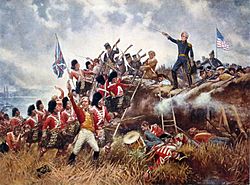
During the final campaign of the War of 1812, the British sent a force of 11,000 soldiers, marines, and sailors, in an attempt to capture New Orleans. Despite great challenges, General Andrew Jackson, with support from the U.S. Navy on the river, successfully cobbled together a motley military force of: militia from Louisiana and Mississippi, including free men of color, U.S. Army regulars, a large contingent of Tennessee state militia, Kentucky riflemen, Choctaw fighters, and local privateers (the latter led by the pirate Jean Lafitte), to decisively defeat the British troops, led by Sir Edward Pakenham, in the Battle of New Orleans on January 8, 1815. The armies had not learned of the Treaty of Ghent which had been signed on December 24, 1814. (However, the treaty did not call for cessation of hostilities until after both governments had ratified the treaty, and the US government did not ratify it until February 16, 1815.) The fighting in Louisiana had begun in December 1814 and did not end until late January, after the Americans held off the British Navy during a ten-day siege of Fort St. Philip. (The Royal Navy went on to capture Fort Bowyer near Mobile, before the commanders received news of the peace treaty.)
As a principal port, New Orleans played a major role during the antebellum era in the Atlantic slave trade. Its port also handled huge quantities of commodities for export from the interior and imported goods from other countries, which were warehoused and transferred in New Orleans to smaller vessels and distributed the length and breadth of the vast Mississippi River watershed. The river in front of the city was filled with steamboats, flatboats, and sailing ships. Despite its role in the slave trade, New Orleans at the same time had the largest and most prosperous community of free persons of color in the nation, who were often educated and middle-class property owners.
Dwarfing in population the other cities in the antebellum South, New Orleans had the largest slave market in the domestic slave trade, which expanded after the United States' ending of the international trade in 1808. Two-thirds of the more than one million slaves brought to the Deep South arrived via the forced migration of the domestic slave trade. The money generated by the sale of slaves in the Upper South has been estimated at 15 percent of the value of the staple crop economy. The slaves represented half a billion dollars in property. An ancillary economy grew up around the trade in slaves—for transportation, housing and clothing, fees, etc., estimated at 13.5 percent of the price per person. All of this amounted to tens of billions of dollars (2005 dollars, adjusted for inflation) during the antebellum period, with New Orleans as a prime beneficiary.
After the Louisiana Purchase, numerous Anglo-Americans migrated to the city. The population of the city doubled in the 1830s and by 1840, New Orleans had become the wealthiest and the third-most populous city in the nation. Large numbers of German and Irish immigrants began arriving in the 1840s, working as laborers in the busy port. In this period, the state legislature passed more restrictions on manumissions of slaves, and virtually ended it in 1852.
In the 1850s, white Francophones remained an intact and vibrant community; they maintained instruction in French in two of the city's four school districts (all were white). In 1860, the city had 13,000 free people of color (gens de couleur libres), the class of free, mostly mixed-race people that developed during French and Spanish rule. The census recorded 81 percent as mulatto, a term used to cover all degrees of mixed race. Mostly part of the Francophone group, they constituted the artisan, educated and professional class of African Americans. Most blacks were still enslaved, working at the port, in domestic service, in crafts, and mostly on the many large, surrounding sugar cane plantations.
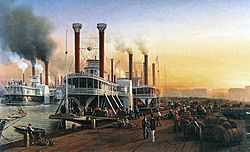
After growing by 45 percent in the 1850s, by 1860, the city had nearly 170,000 people The city was a destination for immigrants. It had grown in wealth, with a "per capita income [that] was second in the nation and the highest in the South." The city had a role as the "primary commercial gateway for the nation's booming mid-section." The port was the third largest in the nation in terms of tonnage of imported goods, after Boston and New York, handling 659,000 tons in 1859.
As the French Creole elite feared, during the Civil War their world changed.
Butler abolished French language instruction in city schools; statewide measures in 1864 and, after the war, 1868 further strengthened English-only policy imposed by federal representatives. With the predominance of English speakers in the city and state, that language had already become dominant in business and government. By the end of the 19th century, French usage in the city had faded significantly; it was also under pressure from new immigrants: English speakers such as the Irish, and other Europeans, such as the Italians and Germans. However, as late as 1902 "one-fourth of the population of the city spoke French in ordinary daily intercourse, while another two-fourths was able to understand the language perfectly," and as late as 1945, one still encountered elderly Creole women who spoke no English. The last major French language newspaper in New Orleans, L'Abeille de la Nouvelle-Orléans (New Orleans Bee), ceased publication on December 27, 1923, after ninety-six years. According to some sources, Le Courrier de la Nouvelle Orleans continued until 1955.
As the city was captured and occupied early in the war, it was spared the destruction through warfare suffered by many other cities of the American South. The Union Army eventually extended its control north along the Mississippi River and along the coastal areas of the State. As a result, most of the southern portion of Louisiana was originally exempted from the liberating provisions of the 1863 "Emancipation Proclamation" issued by President Abraham Lincoln. Large numbers of rural ex-slaves and some free people of color from the city volunteered for the first regiments of Black troops in the War. Led by Brig. Gen. Daniel Ullman (1810–1892), of the 78th Regiment of New York State Volunteers Militia, they were known as the "Corps d'Afrique." While that name had been used by a militia before the war, that group was composed of free people of color. The new group was made up mostly of former slaves. They were supplemented in the last two years of the War by newly organized United States Colored Troops, who played an increasingly important part in the war.
Violence throughout the South, especially the Memphis Riots of 1866 followed by the New Orleans Riot in July of that year, resulted in Congress passing the Reconstruction Act and the Fourteenth Amendment, to extend the protections of full citizenship to freedmen and free people of color. Louisiana and Texas were put under the authority of the "Fifth Military District" of the United States during Reconstruction. Louisiana was eventually readmitted to the Union in 1868; its Constitution of 1868 granted universal manhood suffrage and established universal public education. Both blacks and whites were elected to local and state offices. In 1872, lieutenant governor P.B.S. Pinchback, who was of mixed race, succeeded Henry Clay Warmouth for a brief period as Republican governor of Louisiana, becoming the first governor of African descent of an American state. (The next African American to serve as governor of an American state was Douglas Wilder, elected in Virginia in 1989.) New Orleans even operated a racially-integrated public school system during this period.
Wartime damage to levees and cities along the Mississippi River adversely affected southern crops and trade for the port city for some time. The federal government contributed to restoring infrastructure, but it took time. The nationwide financial recession and Panic of 1873 also adversely affected businesses and slowed economic recovery.
From 1868, elections in Louisiana were marked by violence, as white insurgents tried to suppress black voting and disrupt Republican gatherings. Violence continued around elections. The disputed 1872 gubernatorial election resulted in conflicts that ran for years. The "White League", an insurgent paramilitary group that supported the Democratic Party, was organized in 1874 and operated in the open, violently suppressing the black vote and running off Republican officeholders. In 1874, in the Battle of Liberty Place, 5,000 members of the White League fought with city police to take over the state offices for the Democratic candidate for governor, holding them for three days. By 1876, such tactics resulted in the white Democrats, the so-called Redeemers, regaining political control of the state legislature. The federal government gave up and withdrew its troops in 1877, ending Reconstruction.
White Democrats passed Jim Crow laws, establishing racial segregation in public facilities. In 1889, the legislature passed a constitutional amendment incorporating a "grandfather clause" that effectively disfranchised freedmen as well as the propertied people of color free before the war. Unable to vote, African Americans could not serve on juries or in local office, and were closed out of formal politics for several generations in the state. It was ruled by a white Democratic Party. Public schools were racially segregated and remained so until 1960.
New Orleans' large community of well-educated, often French-speaking free persons of color (gens de couleur libres), who had been free prior to the Civil War, sought to fight back against Jim Crow. They organized the Comité des Citoyens (Citizens Committee) to work for civil rights. As part of their legal campaign, they recruited one of their own, Homer Plessy, to test whether Louisiana's newly enacted Separate Car Act was constitutional. Plessy boarded a commuter train departing New Orleans for Covington, Louisiana, sat in the car reserved for whites only, and was arrested. The case resulting from this incident, Plessy v. Ferguson, was heard by the U.S. Supreme Court in 1896. The court ruled that "separate but equal" accommodations were constitutional, effectively upholding Jim Crow measures. In practice, African-American public schools and facilities were underfunded in Louisiana and across the South. The Supreme Court ruling contributed to this period as the nadir of race relations in the United States. The rate of lynchings of black men was high across the South.
Throughout New Orleans' history, until the early 20th century when medical and scientific advances ameliorated the situation, the city suffered repeated epidemics of yellow fever and other tropical and infectious diseases.
20th century
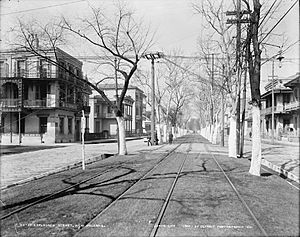
New Orleans' zenith as an economic and population center, in relation to other American cities, occurred in the decades prior to 1860. At this time New Orleans was the nation's fifth-largest city and was significantly larger than all other American South population centers. New Orleans continued to increase in population from the mid-19th century onward, but rapid economic growth shifted to other areas of the country, meaning that New Orleans' relative importance steadily declined. First to emerge in importance were the new industrial and railroad hubs of the Midwest, then the rapidly growing metropolises of the Pacific Coast in the decades before and after the turn of the 20th century. Construction of railways and highways decreased river traffic, diverting goods to other transportation corridors and markets. Thousands of the most ambitious blacks left New Orleans and the state in the Great Migration around World War II and after, many for West Coast destinations. In the post-war period, other Sun Belt cities in the South and West surpassed New Orleans in population.
From the late 1800s, most U.S. censuses recorded New Orleans' slipping rank among American cities. Reminded every ten years of its declining relative importance, New Orleans would periodically mount attempts to regain its economic vigor and pre-eminence, with varying degrees of success.
By the mid-20th century, New Orleanians recognized that their city was being surpassed as the leading urban area in the South. By 1950, Houston, Dallas, and Atlanta exceeded New Orleans in size, and in 1960 Miami eclipsed New Orleans, even as the latter's population reached what would be its historic peak that year. As with other older American cities in the postwar period, highway construction and suburban development drew residents from the center city to newer housing outside. The 1970 census recorded the first absolute decline in the city's population since it joined the United States. The New Orleans metropolitan area continued expanding in population, however, just not as rapidly as other major cities in the Sun Belt. While the port remained one of the largest in the nation, automation and containerization resulted in significant job losses. The city's relative fall in stature meant that its former role as banker to the South was inexorably supplanted by competing companies in larger peer cities. New Orleans' economy had always been based more on trade and financial services than on manufacturing, but the city's relatively small manufacturing sector also shrank in the post–World War II period. Despite some economic development successes under the administrations of DeLesseps "Chep" Morrison (1946–1961) and Victor "Vic" Schiro (1961–1970), metropolitan New Orleans' growth rate consistently lagged behind more vigorous cities.
Civil Rights Movement
During the later years of Morrison's administration, and for the entirety of Schiro's, the city was a center of the Civil Rights Movement. The Southern Christian Leadership Conference was founded in the city, lunch counter sit-ins were held in Canal Street stores, and a prominent and violent series of confrontations occurred in 1960 when the city attempted school desegregation, following the Supreme Court ruling in Brown v. Board of Education (1954). When six-year-old Ruby Bridges integrated William Frantz Elementary School in the city's Ninth Ward, she was the first child of color to attend a previously all-white school in the South. The Civil Rights Movement's success in gaining federal passage of the Civil Rights Act of 1964 and the Voting Rights Act of 1965 provided enforcement of constitutional rights, including voting for blacks. Together, these resulted in the most far-reaching changes in New Orleans' 20th century history.
Though legal and civil equality were re-established by the end of the 1960s, a large gap in income levels and educational attainment persisted between the city's White and African-American communities. As the middle class and wealthier members of both races left the center city, its population's income level dropped, and it became proportionately more African American. From 1980, the African-American majority has elected officials from its own community. They have struggled to narrow the gap by creating conditions conducive to the economic uplift of the African-American community.
New Orleans became increasingly dependent on tourism as an economic mainstay by the administrations of Sidney Barthelemy (1986–1994) and Marc Morial (1994–2002). Relatively low levels of educational attainment, high rates of household poverty, and rising crime threatened the prosperity of the city in the later decades of the century. The negative effects of these socioeconomic conditions contrasted with the changes to the economy of the United States, which were based on a post-industrial, knowledge-based paradigm in which mental skills and education were far more important to advancement than manual skills.
Drainage and flood control
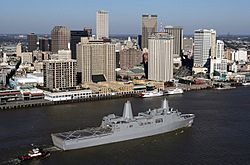
In the 20th century, New Orleans' government and business leaders believed they needed to drain and develop outlying areas to provide for the city's expansion. The most ambitious development during this period was a drainage plan devised by engineer and inventor A. Baldwin Wood, designed to break the surrounding swamp's stranglehold on the city's geographic expansion. Until then, urban development in New Orleans was largely limited to higher ground along the natural river levees and bayous. Wood's pump system allowed the city to drain huge tracts of swamp and marshland and expand into low-lying areas. Over the 20th century, rapid subsidence, both natural and human-induced, resulted in these newly populated areas declining to several feet below sea level.
New Orleans was vulnerable to flooding even before the city's footprint departed from the natural high ground near the Mississippi River. In the late 20th century, however, scientists and New Orleans residents gradually became aware of the city's increased vulnerability. In 1965, flooding from Hurricane Betsy killed dozens of residents, although the majority of the city remained dry. The rain-induced flood of May 8, 1995, demonstrated the weakness of the pumping system. After that event, measures were undertaken to dramatically upgrade pumping capacity. By the 1980s and 1990s, scientists observed that extensive, rapid, and ongoing erosion of the marshlands and swamp surrounding New Orleans, especially that related to the Mississippi River – Gulf Outlet Canal, had the unintended result of leaving the city more exposed to hurricane-induced catastrophic storm surges than earlier in its history.
21st century
Hurricane Katrina

New Orleans was catastrophically affected by what the University of California Berkeley's Dr. Raymond B. Seed called "the worst engineering disaster in the world since Chernobyl", when the Federal levee system failed during Hurricane Katrina in 2005. By the time the hurricane approached the city at the end of August 2005, most residents had evacuated. As the hurricane passed through the Gulf Coast region, the city's federal flood protection system failed, resulting in the worst civil engineering disaster in American history. Floodwalls and levees constructed by the United States Army Corps of Engineers failed below design specifications and 80% of the city flooded. Tens of thousands of residents who had remained in the city were rescued or otherwise made their way to shelters of last resort at the Louisiana Superdome or the New Orleans Morial Convention Center. More than 1,500 people were recorded as having died in Louisiana, most in New Orleans, and others are still unaccounted for. Before Hurricane Katrina, the city called for the first mandatory evacuation in its history, to be followed by another mandatory evacuation three years later with Hurricane Gustav.
Hurricane Rita
The city was declared off-limits to residents while efforts to clean up after Hurricane Katrina began. The approach of Hurricane Rita in September 2005 caused repopulation efforts to be postponed, and the Lower Ninth Ward was reflooded by Rita's storm surge.
Post-disaster recovery
Because of the scale of damage, many people settled permanently outside the city in other areas where they had evacuated, as in Houston. Federal, state, and local efforts have been directed at recovery and rebuilding in severely damaged neighborhoods. The Census Bureau in July 2006 estimated the population of New Orleans to be 223,000; a subsequent study estimated that 32,000 additional residents had moved to the city as of March 2007, bringing the estimated population to 255,000, approximately 56% of the pre-Katrina population level. Another estimate, based on data on utility usage from July 2007, estimated the population to be approximately 274,000 or 60% of the pre-Katrina population. These estimates are somewhat smaller than a third estimate, based on mail delivery records, from the Greater New Orleans Community Data Center in June 2007, which indicated that the city had regained approximately two-thirds of its pre-Katrina population. In 2008, the Census Bureau revised its population estimate for the city upward, to 336,644. Most recently, 2010 estimates show that neighborhoods that did not flood are near 100% of their pre-Katrina populations, and in some cases, exceed 100% of their pre-Katrina populations.
Several major tourist events and other forms of revenue for the city have returned. Large conventions are being held again, such as those held by the American Library Association and American College of Cardiology. College football events such as the Bayou Classic, New Orleans Bowl, and Sugar Bowl returned for the 2006–2007 season. The New Orleans Saints returned that season as well, following speculation of a move. The New Orleans Hornets (now named the Pelicans) returned to the city fully for the 2007–2008 season, having partially spent the 2006–2007 season in Oklahoma City. New Orleans successfully hosted the 2008 NBA All-Star Game and the 2008 BCS National Championship Game. The city hosted the first and second rounds of the 2007 NCAA Men's Division I Basketball Tournament. New Orleans and Tulane University hosted the Final Four Championship in 2012. Additionally, the city hosted the Super Bowl XLVII on February 3, 2013 at the Mercedes-Benz Superdome.
Major annual events such as Mardi Gras and the Jazz & Heritage Festival were never displaced or canceled. Also, an entirely new annual festival, "The Running of the Bulls New Orleans", was created in 2007.
On February 7, 2017, a large EF3 wedge tornado hit parts of the eastern side of the city, causing severe damages to homes and other buildings, as well as destroying a mobile home park. At least 25 people were left injured by the event.
Geography
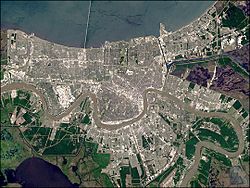
New Orleans is located at 29°57′53″N 90°4′14″W / 29.96472°N 90.07056°W (29.964722, −90.070556) on the banks of the Mississippi River, approximately 105 miles (169 km) upriver from the Gulf of Mexico. According to the U.S. Census Bureau, the city has a total area of 350 square miles (910 km2), of which 169 square miles (440 km2) is land and 181 square miles (470 km2) (52%) is water. Orleans Parish is the smallest parish by land area in Louisiana.
The city is located in the Mississippi River Delta on the east and west banks of the Mississippi River and south of Lake Pontchartrain. The area along the river is characterized by ridges and hollows.
New Orleans was originally settled on the natural levees or high ground, along the Mississippi River. After the Flood Control Act of 1965, the US Army Corps of Engineers built floodwalls and man-made levees around a much larger geographic footprint that included previous marshland and swamp. Whether or not this human interference has caused subsidence is a topic of debate. A study by an associate professor at Tulane University claims:
While erosion and wetland loss are huge problems along Louisiana's coast, the basement 30 to 50 feet (15 m) beneath much of the Mississippi Delta has been highly stable for the past 8,000 years with negligible subsidence rates.
In May 2016, NASA published a study that details the sinking rate of New Orleans.
A recent study by Tulane and Xavier University notes that 51% of New Orleans is at or above sea level, with the more densely populated areas generally on higher ground. The average elevation of the city is currently between one and two feet (0.5 m) below sea level, with some portions of the city as high as 20 feet (6 m) at the base of the river levee in Uptown and others as low as 7 feet (2 m) below sea level in the farthest reaches of Eastern New Orleans.
In 2005, storm surge from Hurricane Katrina caused catastrophic failure of the federally designed and built levees, flooding 80% of the city. A report by the American Society of Civil Engineers says that "had the levees and floodwalls not failed and had the pump stations operated, nearly two-thirds of the deaths would not have occurred".
New Orleans has always had to consider the risk of hurricanes, but the risks are dramatically greater today due to coastal erosion from human interference. Since the beginning of the 20th century, it has been estimated that Louisiana has lost 2,000 square miles (5,000 km2) of coast (including many of its barrier islands), which once protected New Orleans against storm surge. Following Hurricane Katrina, the Army Corps of Engineers has instituted massive levee repair and hurricane protection measures to protect the city.
In 2006, Louisiana voters overwhelmingly adopted an amendment to the state's constitution to dedicate all revenues from off-shore drilling to restore Louisiana's eroding coast line. Congress has allocated $7 billion to bolster New Orleans' flood protection.
According to a study by the National Academy of Engineering and the National Research Council, levees and floodwalls surrounding New Orleans—no matter how large or sturdy—cannot provide absolute protection against overtopping or failure in extreme events. Levees and floodwalls should be viewed as a way to reduce risks from hurricanes and storm surges, not as measures that completely eliminate risk. For structures in hazardous areas and residents who do not relocate, the committee recommended major floodproofing measures—such as elevating the first floor of buildings to at least the 100-year flood level.
Cityscape
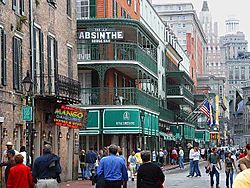
The Central Business District of New Orleans is located immediately north and west of the Mississippi River, and was historically called the "American Quarter" or "American Sector." It was developed after the heart of French and Spanish settlement. It includes Lafayette Square. Most streets in this area fan out from a central point in the city. Major streets of the area include Canal Street, Poydras Street, Tulane Avenue and Loyola Avenue. Canal Street functions as the street which divides the traditional "downtown" area from the "uptown" area.
Every street crossing Canal Street between the Mississippi River and Rampart Street, which is the northern edge of the French Quarter, has a different name for the "uptown" and "downtown" portions. For example, St. Charles Avenue, known for its street car line, is called Royal Street below Canal Street, though where it traverses the Central Business District between Canal and Lee Circle, it is properly called St. Charles Street. Elsewhere in the city, Canal Street serves as the dividing point between the "South" and "North" portions of various streets. In the local parlance downtown means "downriver from Canal Street", while uptown means "upriver from Canal Street". Downtown neighborhoods include the French Quarter, Tremé, the 7th Ward, Faubourg Marigny, Bywater (the Upper Ninth Ward), and the Lower Ninth Ward. Uptown neighborhoods include the Warehouse District, the Lower Garden District, the Garden District, the Irish Channel, the University District, Carrollton, Gert Town, Fontainebleau, and Broadmoor. However, the Warehouse and the Central Business District, despite being above Canal Street, are frequently called "Downtown" as a specific region, as in the Downtown Development District.
Other major districts within the city include Bayou St. John, Mid-City, Gentilly, Lakeview, Lakefront, New Orleans East, and Algiers.
Historic and residential architecture
New Orleans is world-famous for its abundance of unique architectural styles which reflect the city's historical roots and multicultural heritage. Though New Orleans possesses numerous structures of national architectural significance, it is equally, if not more, revered for its enormous, largely intact (even post-Katrina) historic built environment. Twenty National Register Historic Districts have been established, and fourteen local historic districts aid in the preservation of this tout ensemble. Thirteen of the local historic districts are administered by the New Orleans Historic District Landmarks Commission (HDLC), while one—the French Quarter—is administered by the Vieux Carre Commission (VCC). Additionally, both the National Park Service, via the National Register of Historic Places, and the HDLC have landmarked individual buildings, many of which lie outside the boundaries of existing historic districts.
Many styles of housing exist in the city, including the shotgun house and the bungalow style. Creole townhouses, notable for their large courtyards and intricate iron balconies, line the streets of the French Quarter. Throughout the city, there are many other historic housing styles: Creole cottages, American townhouses, double-gallery houses, and Raised Center-Hall Cottages. St. Charles Avenue is famed for its large antebellum homes. Its mansions are in various styles, such as Greek Revival, American Colonial and the Victorian styles of Queen Anne and Italianate architecture. New Orleans is also noted for its large, European-style Catholic cemeteries, which can be found throughout the city.
Tallest buildings

For much of its history, New Orleans' skyline consisted of only low- and mid- rise structures. The soft soils of New Orleans are susceptible to subsidence, and there was doubt about the feasibility of constructing large high rises in such an environment. Developments in engineering throughout the twentieth century eventually made it possible to build sturdy foundations to support high rise structures in the city, and in the 1960s, the World Trade Center New Orleans and Plaza Tower were built, demonstrating the viability of tall skyscrapers in New Orleans. One Shell Square took its place as the city's tallest building in 1972. The oil boom of the 1970s and early 1980s redefined New Orleans' skyline with the development of the Poydras Street corridor. Today, most of New Orleans' tallest buildings are clustered along Canal Street and Poydras Street in the Central Business District.
| Name | Stories | Height |
|---|---|---|
| One Shell Square | 51 | 697 ft (212 m) |
| Place St. Charles | 53 | 645 ft (197 m) |
| Plaza Tower | 45 | 531 ft (162 m) |
| Energy Centre | 39 | 530 ft (160 m) |
| First Bank and Trust Tower | 36 | 481 ft (147 m) |
Climate
| Climate data for New Orleans Int'l (1981–2010 normals, extremes 1946–present) | |||||||||||||
|---|---|---|---|---|---|---|---|---|---|---|---|---|---|
| Month | Jan | Feb | Mar | Apr | May | Jun | Jul | Aug | Sep | Oct | Nov | Dec | Year |
| Record high °F (°C) | 83 (28) |
85 (29) |
89 (32) |
92 (33) |
96 (36) |
101 (38) |
101 (38) |
102 (39) |
101 (38) |
94 (34) |
87 (31) |
84 (29) |
102 (39) |
| Mean maximum °F (°C) | 77.2 (25.1) |
78.9 (26.1) |
82.3 (27.9) |
86.7 (30.4) |
91.5 (33.1) |
94.5 (34.7) |
96.0 (35.6) |
96.4 (35.8) |
93.5 (34.2) |
89.0 (31.7) |
83.7 (28.7) |
79.7 (26.5) |
97.3 (36.3) |
| Mean daily maximum °F (°C) | 62.1 (16.7) |
65.4 (18.6) |
71.8 (22.1) |
78.2 (25.7) |
85.2 (29.6) |
89.5 (31.9) |
91.2 (32.9) |
91.2 (32.9) |
87.5 (30.8) |
80.0 (26.7) |
71.8 (22.1) |
64.4 (18.0) |
78.2 (25.7) |
| Mean daily minimum °F (°C) | 44.7 (7.1) |
48.0 (8.9) |
53.5 (11.9) |
60.0 (15.6) |
68.1 (20.1) |
73.5 (23.1) |
75.3 (24.1) |
75.3 (24.1) |
72.0 (22.2) |
62.6 (17.0) |
53.5 (11.9) |
46.9 (8.3) |
61.2 (16.2) |
| Mean minimum °F (°C) | 27.6 (−2.4) |
31.3 (−0.4) |
36.8 (2.7) |
44.6 (7.0) |
56.0 (13.3) |
65.7 (18.7) |
69.9 (21.1) |
70.0 (21.1) |
60.6 (15.9) |
45.6 (7.6) |
37.6 (3.1) |
29.6 (−1.3) |
24.6 (−4.1) |
| Record low °F (°C) | 14 (−10) |
16 (−9) |
25 (−4) |
32 (0) |
41 (5) |
50 (10) |
60 (16) |
60 (16) |
42 (6) |
35 (2) |
24 (−4) |
11 (−12) |
11 (−12) |
| Average precipitation inches (mm) | 5.15 (131) |
5.30 (135) |
4.55 (116) |
4.61 (117) |
4.63 (118) |
8.06 (205) |
5.93 (151) |
5.98 (152) |
4.97 (126) |
3.54 (90) |
4.49 (114) |
5.24 (133) |
62.45 (1,586) |
| Average precipitation days (≥ 0.01 in) | 9.3 | 8.8 | 8.3 | 6.9 | 7.7 | 12.9 | 13.6 | 13.1 | 9.4 | 7.7 | 7.9 | 9.2 | 114.8 |
| Average relative humidity (%) | 75.6 | 73.0 | 72.9 | 73.4 | 74.4 | 76.4 | 79.2 | 79.4 | 77.8 | 74.9 | 77.2 | 76.9 | 75.9 |
| Mean monthly sunshine hours | 153.0 | 161.5 | 219.4 | 251.9 | 278.9 | 274.3 | 257.1 | 251.9 | 228.7 | 242.6 | 171.8 | 157.8 | 2,648.9 |
| Percent possible sunshine | 47 | 52 | 59 | 65 | 66 | 65 | 60 | 62 | 62 | 68 | 54 | 50 | 60 |
| Source: NOAA (relative humidity and sun 1961–1990) | |||||||||||||
| Climate data for Audubon Park, New Orleans (extremes 1893–present) | |||||||||||||
|---|---|---|---|---|---|---|---|---|---|---|---|---|---|
| Month | Jan | Feb | Mar | Apr | May | Jun | Jul | Aug | Sep | Oct | Nov | Dec | Year |
| Record high °F (°C) | 84 (29) |
85 (29) |
91 (33) |
93 (34) |
99 (37) |
104 (40) |
102 (39) |
103 (39) |
101 (38) |
97 (36) |
92 (33) |
85 (29) |
104 (40) |
| Record low °F (°C) | 13 (−11) |
6 (−14) |
26 (−3) |
32 (0) |
46 (8) |
54 (12) |
61 (16) |
60 (16) |
49 (9) |
35 (2) |
26 (−3) |
12 (−11) |
6 (−14) |
| Source: NOAA | |||||||||||||
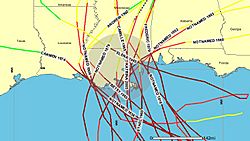
The climate of New Orleans is humid subtropical (Köppen climate classification Cfa), with short, generally mild winters and hot, humid summers; most suburbs and parts of Wards 9 and 15 fall in USDA Plant Hardiness Zone 9a, while the city's other 15 wards are rated 9b in whole. The monthly daily average temperature ranges from 53.4 °F (11.9 °C) in January to 83.3 °F (28.5 °C) in July and August. Officially, as measured at New Orleans International Airport, temperature records range from 11 to 102 °F (−12 to 39 °C) on December 23, 1989 and August 22, 1980, respectively; Audubon Park has recorded temperatures ranging from 6 °F (−14 °C) on February 13, 1899 up to 104 °F (40 °C) on June 24, 2009. Dewpoints in the summer months (June–August) are relatively high, ranging from 71.1 to 73.4 °F (21.7 to 23.0 °C).
The average precipitation is 62.5 inches (1,590 mm) annually; the summer months are the wettest, while October is the driest month. Precipitation in winter usually accompanies the passing of a cold front. On average, there are 77 days of 90 °F (32 °C)+ highs, 8.1 days per winter where the high does not exceed 50 °F (10 °C), and 8.0 nights with freezing lows annually. It is rare for the temperature to reach 20 or 100 °F (−7 or 38 °C), with the last occurrence of each being February 5, 1996 and June 26, 2016, respectively.
Hurricanes pose a severe threat to the area, and the city is particularly at risk because of its low elevation; because it is surrounded by water from the north, east, and south; and because of Louisiana's sinking coast. According to the Federal Emergency Management Agency, New Orleans is the nation's most vulnerable city to hurricanes. Indeed, portions of Greater New Orleans have been flooded by: the Grand Isle Hurricane of 1909, the New Orleans Hurricane of 1915, 1947 Fort Lauderdale Hurricane, Hurricane Flossy in 1956, Hurricane Betsy in 1965, Hurricane Georges in 1998, Hurricanes Katrina and Rita in 2005, and Hurricane Gustav in 2008, with the flooding in Betsy being significant and in a few neighborhoods severe, and that in Katrina being disastrous in the majority of the city. New Orleans experiences snowfall only on rare occasions. A small amount of snow fell during the 2004 Christmas Eve Snowstorm and again on Christmas (December 25) when a combination of rain, sleet, and snow fell on the city, leaving some bridges icy. Before that, the last White Christmas was in 1964 and brought 4.5 inches (11 cm). Snow fell again on December 22, 1989, when most of the city received 1–2 inches (2.5–5.1 cm).
The last significant snowfall in New Orleans was on the morning of December 11, 2008.
Demographics
| Historical population | ||
|---|---|---|
| Year | Pop. | ±% |
| 1769 | 3,190 | — |
| 1778 | 3,060 | −4.1% |
| 1791 | 5,497 | +79.6% |
| 1810 | 17,242 | +213.7% |
| 1820 | 27,176 | +57.6% |
| 1830 | 46,082 | +69.6% |
| 1840 | 102,193 | +121.8% |
| 1850 | 116,375 | +13.9% |
| 1860 | 168,675 | +44.9% |
| 1870 | 191,418 | +13.5% |
| 1880 | 216,090 | +12.9% |
| 1890 | 242,039 | +12.0% |
| 1900 | 287,104 | +18.6% |
| 1910 | 339,075 | +18.1% |
| 1920 | 387,219 | +14.2% |
| 1930 | 458,762 | +18.5% |
| 1940 | 494,537 | +7.8% |
| 1950 | 570,445 | +15.3% |
| 1960 | 627,525 | +10.0% |
| 1970 | 593,471 | −5.4% |
| 1980 | 557,515 | −6.1% |
| 1990 | 496,938 | −10.9% |
| 2000 | 484,674 | −2.5% |
| 2010 | 343,829 | −29.1% |
| 2020 | 383,997 | +11.7% |
| 2023 (est.) | 364,136 | −5.2% |
| Population given for the City of New Orleans, not for Orleans Parish, before New Orleans absorbed suburbs and rural areas of Orleans Parish in 1874, since which time the city and parish have been coterminous. Population for Orleans Parish was 41,351 in 1820; 49,826 in 1830; 102,193 in 1840; 119,460 in 1850; 174,491 in 1860; and 191,418 in 1870. Source: U.S. Decennial Census Historical Population Figures 1790–1960 1900–1990 1990–2000 2010–2013 2020 estimate |
||
From the 2010 U.S. census to 2014 census estimates the city grew by 12%, adding an average of more than 10,000 new residents each year following the official decennial census. According to the 2020 United States census, there were 383,997 people, 151,753 households, and 69,370 families residing in the city. Prior to 1960, the population of New Orleans steadily increased to a historic 627,525.
Beginning in 1960, the population decreased due to factors such as the cycles of oil production and tourism, and as suburbanization increased (as with many cities), and jobs migrated to surrounding parishes. This economic and population decline resulted in high levels of poverty in the city; in 1960 it had the fifth-highest poverty rate of all U.S. cities, and was almost twice the national average in 2005, at 24.5%. New Orleans experienced an increase in residential segregation from 1900 to 1980, leaving the disproportionately Black and African American poor in older, low-lying locations. These areas were especially susceptible to flood and storm damage.
The last population estimate before Hurricane Katrina was 454,865, as of July 1, 2005. A population analysis released in August 2007 estimated the population to be 273,000, 60% of the pre-Katrina population and an increase of about 50,000 since July 2006. A September 2007 report by The Greater New Orleans Community Data Center, which tracks population based on U.S. Postal Service figures, found that in August 2007, just over 137,000 households received mail. That compares with about 198,000 households in July 2005, representing about 70% of pre-Katrina population. In 2010, the U.S. Census Bureau revised upward its 2008 population estimate for the city, to 336,644 inhabitants. Estimates from 2010 showed that neighborhoods that did not flood were near or even greater than 100% of their pre-Katrina populations.
A 2006 study by researchers at Tulane University and the University of California, Berkeley determined that as many as 10,000 to 14,000 undocumented immigrants, many from Mexico, resided in New Orleans. In 2016, the Pew Research Center estimated at least 35,000 undocumented immigrants lived in New Orleans and its metropolitan area. The New Orleans Police Department began a new policy to "no longer cooperate with federal immigration enforcement" beginning on February 28, 2016.
As of 2010[update], 90.3% of residents age 5 and older spoke English at home as a primary language, while 4.8% spoke Spanish, 1.9% Vietnamese, and 1.1% spoke French. In total, 9.7% population age 5 and older spoke a mother language other than English.
Race and ethnicity
| Racial and ethnic composition | 2020 | 2010 | 1990 | 1970 | 1940 |
|---|---|---|---|---|---|
| White | n/a | 33.0% | 34.9% | 54.5% | 69.7% |
| —Non-Hispanic | 31.61% | 30.5% | 33.1% | 50.6% | n/a |
| Black or African American | 53.61% | 60.2% | 61.9% | 45.0% | 30.1% |
| Hispanic or Latino (of any race) | 8.08% | 5.2% | 3.5% | 4.4% | n/a |
| Asian | 2.75% | 2.9% | 1.9% | 0.2% | 0.1% |
| Pacific Islander | 0.03% | n/a | n/a | n/a | n/a |
| Two or more races | 3.71% | 1.7% | n/a | n/a | n/a |
Growing into a predominant Black and African American city by race and ethnicity since 1990, in 2010 the racial and ethnic makeup of New Orleans was: 60.2% Black and African American, 33.0% White, 2.9% Asian (1.7% Vietnamese, 0.3% Indian, 0.3% Chinese, 0.1% Filipino, 0.1% Korean), 0.0% Pacific Islander, and 1.7% people of two or more races. People of Hispanic or Latino American origin made up 5.3% of the population; 1.3% were Mexican, 1.3% Honduran, 0.4% Cuban, 0.3% Puerto Rican, and 0.3% Nicaraguan. In 2020, the racial and ethnic makeup of the city was 53.61% Black or African American, 31.61% non-Hispanic white, 0.2% American Indian and Alaska Native, 0.03% Pacific Islander, 3.71% multiracial or of another race, and 8.08% Hispanic and Latino American of any race. The growth of the Hispanic and Latino population in New Orleans proper from 2010 to 2020 reflected national demographic trends of diversification throughout regions once predominantly non-Hispanic white.
As of 2011[update], the Hispanic and Latino American population had also grown in the Greater New Orleans area alongside Black and African American residents, including in Kenner, central Metairie, and Terrytown in Jefferson Parish and Eastern New Orleans and Mid-City in New Orleans proper. Janet Murguía, president and chief executive officer of the National Council of La Raza, stated that up to 120,000 Hispanic and Latino Americans workers lived in New Orleans. In June 2007, one study stated that the Hispanic and Latino American population had risen from 15,000, pre-Katrina, to over 50,000. From 2010 to 2014 the city grew by 12%, adding an average of more than 10,000 new residents each year following the 2010 U.S. census.
After Katrina the small Brazilian American population expanded. Portuguese speakers were the second most numerous group to take English as a second language classes in the Roman Catholic Archdiocese of New Orleans, after Spanish speakers. Many Brazilians worked in skilled trades such as tile and flooring, although fewer worked as day laborers than other Hispanic and Latino Americans. Many had moved from Brazilian communities in the northeastern United States, and Florida and Georgia. Brazilians settled throughout the metropolitan area; most were undocumented. In January 2008, the New Orleans Brazilian population had a mid-range estimate of 3,000 people. By 2008, Brazilians had opened many small churches, shops and restaurants catering to their community.
Among the growing Asian American community, the earliest Filipino Americans to live within the city arrived in the early 1800s. The Vietnamese American community grew to become the largest by 2010 as many fled the aftermath of the Vietnam War in the 1970s.
Religion
New Orleans' colonial history of French and Spanish settlement generated a strong Roman Catholic tradition. Catholic missions ministered to slaves and free people of color and established schools for them. In addition, many late 19th and early 20th century European immigrants, such as the Irish, some Germans, and Italians were Catholic. Within the Roman Catholic Archdiocese of New Orleans (which includes not only the city but the surrounding parishes as well), 40% percent of the population was Roman Catholic since 2016. Catholicism is reflected in French and Spanish cultural traditions, including its many parochial schools, street names, architecture and festivals, including Mardi Gras.
Influenced by the Bible Belt's prominent Protestant population, New Orleans also has a sizable non-Catholic Christian demographic. Roughly 12.2% of the population were Baptist, followed by 5.1% from another Christian faith including Eastern Orthodox Christianity or Oriental Orthodoxy, 3.1% Methodism, 1.8% Episcopalianism, 0.9% Presbyterianism, 0.8% Lutheranism, 0.8% from the Latter-Day Saints, and 0.6% Pentecostalism in 2019. Of the Baptist population, the majority form the National Baptist Convention (USA), National Baptist Convention of America, and the Southern Baptist Convention.
New Orleans displays a distinctive variety of Louisiana Voodoo, due in part to syncretism with African and Afro-Caribbean Roman Catholic beliefs. The fame of voodoo practitioner Marie Laveau contributed to this, as did New Orleans' Caribbean cultural influences. Although the tourism industry strongly associated Voodoo with the city, only a small number of people are serious adherents.
New Orleans was also home to the occultist Mary Oneida Toups, who was nicknamed the "Witch Queen of New Orleans". Toups' coven, The Religious Order of Witchcraft, was the first coven to be officially recognized as a religious institution by the state of Louisiana.
Jewish settlers, primarily Sephardim, settled in New Orleans from the early nineteenth century. Some migrated from the communities established in the colonial years in Charleston, South Carolina and Savannah, Georgia. The merchant Abraham Cohen Labatt helped found the first Jewish congregation in New Orleans in the 1830s, which became known as the Portuguese Jewish Nefutzot Yehudah congregation (he and some other members were Sephardic Jews, whose ancestors had lived in Portugal and Spain). Ashkenazi Jews from eastern Europe immigrated in the late 19th and 20th centuries.
By the 21st century, 10,000 Jews lived in New Orleans. This number dropped to 7,000 after Hurricane Katrina, but rose again after efforts to incentivize the community's growth resulted in the arrival of about an additional 2,000 Jews. New Orleans synagogues lost members, but most re-opened in their original locations. The exception was Congregation Beth Israel, the oldest and most prominent Orthodox synagogue in the New Orleans region. Beth Israel's building in Lakeview was destroyed by flooding. After seven years of holding services in temporary quarters, the congregation consecrated a new synagogue on land purchased from the Reform Congregation Gates of Prayer in Metairie.
A visible religious minority, Muslims constituted 0.6% of the religious population as of 2019. The Islamic demographic in New Orleans and its metropolitan area have been mainly made up of Middle Eastern immigrants and African Americans.
Economy
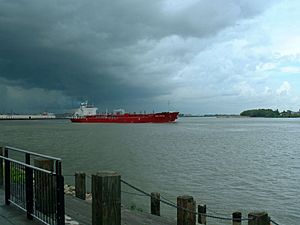

New Orleans operates one of the world's largest and busiest ports and metropolitan New Orleans is a center of maritime industry. The region accounts for a significant portion of the nation's oil refining and petrochemical production, and serves as a white-collar corporate base for onshore and offshore petroleum and natural gas production. Since the beginning of the 21st century, New Orleans has also grown into a technology hub.
New Orleans is also a center for higher learning, with over 50,000 students enrolled in the region's eleven two- and four-year degree-granting institutions. Tulane University, a top-50 research university, is located in Uptown. Metropolitan New Orleans is a major regional hub for the health care industry and boasts a small, globally competitive manufacturing sector. The center city possesses a rapidly growing, entrepreneurial creative industries sector and is renowned for its cultural tourism. Greater New Orleans, Inc. (GNO, Inc.) acts as the first point-of-contact for regional economic development, coordinating between Louisiana's Department of Economic Development and the various business development agencies.
Port
New Orleans began as a strategically located trading entrepôt and it remains, above all, a crucial transportation hub and distribution center for waterborne commerce. The Port of New Orleans is the fifth-largest in the United States based on cargo volume, and second-largest in the state after the Port of South Louisiana. It is the twelfth-largest in the U.S. based on cargo value. The Port of South Louisiana, also located in the New Orleans area, is the world's busiest in terms of bulk tonnage. When combined with Port of New Orleans, it forms the 4th-largest port system in volume. Many shipbuilding, shipping, logistics, freight forwarding and commodity brokerage firms either are based in metropolitan New Orleans or maintain a local presence. Examples include Intermarine, Bisso Towboat, Northrop Grumman Ship Systems, Trinity Yachts, Expeditors International, Bollinger Shipyards, IMTT, International Coffee Corp, Boasso America, Transoceanic Shipping, Transportation Consultants Inc., Dupuy Storage & Forwarding and Silocaf. The largest coffee-roasting plant in the world, operated by Folgers, is located in New Orleans East.
New Orleans is located near to the Gulf of Mexico and its many oil rigs. Louisiana ranks fifth among states in oil production and eighth in reserves. It has two of the four Strategic Petroleum Reserve (SPR) storage facilities: West Hackberry in Cameron Parish and Bayou Choctaw in Iberville Parish. The area hosts 17 petroleum refineries, with a combined crude oil distillation capacity of nearly 2.8 million barrels per day (450,000 m3/d), the second highest after Texas. Louisiana's numerous ports include the Louisiana Offshore Oil Port (LOOP), which is capable of receiving the largest oil tankers. Given the quantity of oil imports, Louisiana is home to many major pipelines: Crude Oil (Exxon, Chevron, BP, Texaco, Shell, Scurloch-Permian, Mid-Valley, Calumet, Conoco, Koch Industries, Unocal, U.S. Dept. of Energy, Locap); Product (TEPPCO Partners, Colonial, Plantation, Explorer, Texaco, Collins); and Liquefied Petroleum Gas (Dixie, TEPPCO, Black Lake, Koch, Chevron, Dynegy, Kinder Morgan Energy Partners, Dow Chemical Company, Bridgeline, FMP, Tejas, Texaco, UTP). Several energy companies have regional headquarters in the area, including Shell plc, Eni and Chevron. Other energy producers and oilfield services companies are headquartered in the city or region, and the sector supports a large professional services base of specialized engineering and design firms, as well as a term office for the federal government's Minerals Management Service.
Business
The city is the home to a single Fortune 500 company: Entergy, a power generation utility and nuclear power plant operations specialist. After Katrina, the city lost its other Fortune 500 company, Freeport-McMoRan, when it merged its copper and gold exploration unit with an Arizona company and relocated that division to Phoenix. Its McMoRan Exploration affiliate remains headquartered in New Orleans.
Companies with significant operations or headquarters in New Orleans include: Pan American Life Insurance, Pool Corp, Rolls-Royce, Newpark Resources, AT&T, TurboSquid, iSeatz, IBM, Navtech, Superior Energy Services, Textron Marine & Land Systems, McDermott International, Pellerin Milnor, Lockheed Martin, Imperial Trading, Laitram, Harrah's Entertainment, Stewart Enterprises, Edison Chouest Offshore, Zatarain's, Waldemar S. Nelson & Co., Whitney National Bank, Capital One, Tidewater Marine, Popeyes Chicken & Biscuits, Parsons Brinckerhoff, MWH Global, CH2M Hill, Energy Partners Ltd, The Receivables Exchange, GE Capital, and Smoothie King.
Entrepreneurship is encouraged, with a number of initiatives designed to support small business and start-ups, including Entrepreneurs' Row and the New Orleans Startup Fund.
Tourist and convention business
Tourism is a staple of the city's economy. Perhaps more visible than any other sector, New Orleans' tourist and convention industry is a $5.5 billion industry that accounts for 40 percent of city tax revenues. In 2004, the hospitality industry employed 85,000 people, making it the city's top economic sector as measured by employment. New Orleans also hosts the World Cultural Economic Forum (WCEF). The forum, held annually at the New Orleans Morial Convention Center, is directed toward promoting cultural and economic development opportunities through the strategic convening of cultural ambassadors and leaders from around the world. The first WCEF took place in October 2008.
Federal and military agencies
Federal agencies and the Armed forces operate significant facilities there. The U.S. Fifth Circuit Court of Appeals operates at the US. Courthouse downtown. NASA's Michoud Assembly Facility is located in New Orleans East and has multiple tenants including Lockheed Martin and Boeing. It is a huge manufacturing complex that produced the external fuel tanks for the Space Shuttles, the Saturn V first stage, the Integrated Truss Structure of the International Space Station, and is now used for the construction of NASA's Space Launch System. The rocket factory lies within the enormous New Orleans Regional Business Park, also home to the National Finance Center, operated by the United States Department of Agriculture (USDA), and the Crescent Crown distribution center. Other large governmental installations include the U.S. Navy's Space and Naval Warfare (SPAWAR) Systems Command, located within the University of New Orleans Research and Technology Park in Gentilly, Naval Air Station Joint Reserve Base New Orleans; and the headquarters for the Marine Force Reserves in Federal City in Algiers.
Culture and contemporary life
Tourism
New Orleans has many visitor attractions, from the world-renowned French Quarter to St. Charles Avenue, (home of Tulane and Loyola universities, the historic Pontchartrain Hotel and many 19th-century mansions) to Magazine Street with its boutique stores and antique shops.
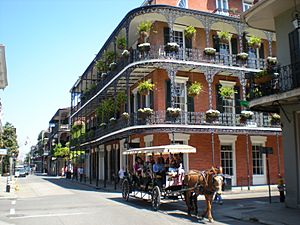
According to current travel guides, New Orleans is one of the top ten most-visited cities in the United States; 10.1 million visitors came to New Orleans in 2004. Prior to Katrina, 265 hotels with 38,338 rooms operated in the Greater New Orleans Area. In May 2007, that had declined to some 140 hotels and motels with over 31,000 rooms.
A 2009 Travel + Leisure poll of "America's Favorite Cities" ranked New Orleans first in ten categories, the most first-place rankings of the 30 cities included. According to the poll, New Orleans was the best U.S. city as a spring break destination and for "wild weekends", stylish boutique hotels, cocktail hours, singles/bar scenes, live music/concerts and bands, antique and vintage shops, cafés/coffee bars, neighborhood restaurants, and people watching. The city ranked second for: friendliness (behind Charleston, South Carolina), gay-friendliness (behind San Francisco), bed and breakfast hotels/inns, and ethnic food. However, the city placed near the bottom in cleanliness, safety and as a family destination.
The French Quarter (known locally as "the Quarter" or Vieux Carré), which was the colonial-era city and is bounded by the Mississippi River, Rampart Street, Canal Street, and Esplanade Avenue, contains popular hotels, bars and nightclubs. Notable tourist attractions in the Quarter include Bourbon Street, Jackson Square, St. Louis Cathedral, the French Market (including Café du Monde, famous for café au lait and beignets) and Preservation Hall. Also in the French Quarter is the old New Orleans Mint, a former branch of the United States Mint which now operates as a museum, and The Historic New Orleans Collection, a museum and research center housing art and artifacts relating to the history and the Gulf South.
Close to the Quarter is the Tremé community, which contains the New Orleans Jazz National Historical Park and the New Orleans African American Museum—a site which is listed on the Louisiana African American Heritage Trail.
The Natchez is an authentic steamboat with a calliope that cruises the length of the city twice daily. Unlike most other places in the United States, New Orleans has become widely known for its elegant decay. The city's historic cemeteries and their distinct above-ground tombs are attractions in themselves, the oldest and most famous of which, Saint Louis Cemetery, greatly resembles Père Lachaise Cemetery in Paris.
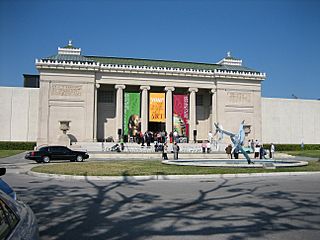
The National WWII Museum offers a multi-building odyssey through the history of the Pacific and European theaters. Nearby, Confederate Memorial Hall Museum, the oldest continually operating museum in Louisiana (although under renovation since Hurricane Katrina), contains the second-largest collection of Confederate memorabilia. Art museums include the Contemporary Arts Center, the New Orleans Museum of Art (NOMA) in City Park, and the Ogden Museum of Southern Art.
New Orleans is home to the Audubon Nature Institute (which consists of Audubon Park, the Audubon Zoo, the Aquarium of the Americas and the Audubon Insectarium), and home to gardens which include Longue Vue House and Gardens and the New Orleans Botanical Garden. City Park, one of the country's most expansive and visited urban parks, has one of the largest stands of oak trees in the world.
Other points of interest can be found in the surrounding areas. Many wetlands are found nearby, including Honey Island Swamp and Barataria Preserve. Chalmette Battlefield and National Cemetery, located just south of the city, is the site of the 1815 Battle of New Orleans.
Entertainment and performing arts
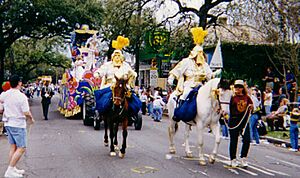
The New Orleans area is home to numerous annual celebrations. The most well known is Carnival, or Mardi Gras. Carnival officially begins on the Feast of the Epiphany, also known in some Christian traditions as the "Twelfth Night" of Christmas. Mardi Gras (French for "Fat Tuesday"), the final and grandest day of traditional Catholic festivities, is the last Tuesday before the Christian liturgical season of Lent, which commences on Ash Wednesday.
The largest of the city's many music festivals is the New Orleans Jazz & Heritage Festival. Commonly referred to simply as "Jazz Fest", it is one of the nation's largest music festivals. The festival features a variety of music, including both native Louisiana and international artists. Along with Jazz Fest, New Orleans' Voodoo Experience ("Voodoo Fest") and the Essence Music Festival also feature local and international artists.
Other major festivals include Southern Decadence, the French Quarter Festival, and the Tennessee Williams/New Orleans Literary Festival. The American playwright lived and wrote in New Orleans early in his career, and set his play, Streetcar Named Desire, there.
In 2002, Louisiana began offering tax incentives for film and television production. This has resulted in a substantial increase in activity and brought the nickname of "Hollywood South" for New Orleans. Films produced in and around the city include Ray, Runaway Jury, The Pelican Brief, Glory Road, All the King's Men, Déjà Vu, Last Holiday, The Curious Case of Benjamin Button, 12 Years a Slave, and Project Power. In 2006, work began on the Louisiana Film & Television studio complex, based in the Tremé neighborhood. Louisiana began to offer similar tax incentives for music and theater productions in 2007, and some commentators began to refer to New Orleans as "Broadway South".
The first theatre in New Orleans was the French-language Theatre de la Rue Saint Pierre, which opened in 1792. The first opera in New Orleans was performed there in 1796. In the nineteenth century, the city was the home of two of America's most important venues for French opera, the Théâtre d'Orléans and later the French Opera House. Today, opera is performed by the New Orleans Opera. The Marigny Opera House is home to the Marigny Opera Ballet and also hosts opera, jazz, and classical music performances.
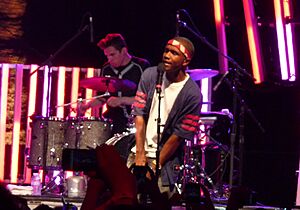
New Orleans has long been a significant center for music, showcasing its intertwined European, African and Latino American cultures. The city's unique musical heritage was born in its colonial and early American days from a unique blending of European musical instruments with African rhythms. As the only North American city to have allowed slaves to gather in public and play their native music (largely in Congo Square, now located within Louis Armstrong Park), New Orleans gave birth in the early 20th century to an epochal indigenous music: jazz. Soon, African American brass bands formed, beginning a century-long tradition. The Louis Armstrong Park area, near the French Quarter in Tremé, contains the New Orleans Jazz National Historical Park. The city's music was later also significantly influenced by Acadiana, home of Cajun and Zydeco music, and by Delta blues.
New Orleans' unique musical culture is on display in its traditional funerals. A spin on military funerals, New Orleans' traditional funerals feature sad music (mostly dirges and hymns) in processions on the way to the cemetery and happier music (hot jazz) on the way back. Until the 1990s, most locals preferred to call these "funerals with music". Visitors to the city have long dubbed them "jazz funerals".
Much later in its musical development, New Orleans was home to a distinctive brand of rhythm and blues that contributed greatly to the growth of rock and roll. An example of the New Orleans' sound in the 1960s is the No. 1 U.S. hit "Chapel of Love" by the Dixie Cups, a song which knocked the Beatles out of the top spot on the Billboard Hot 100. New Orleans became a hotbed for funk music in the 1960s and 1970s, and by the late 1980s, it had developed its own localized variant of hip hop, called bounce music. While not commercially successful outside of the Deep South, bounce music was immensely popular in poorer neighborhoods throughout the 1990s.
..... Additionally, the popularity of cowpunk, a fast form of southern rock, originated with the help of several local bands, such as The Radiators, Better Than Ezra, Cowboy Mouth and Dash Rip Rock. Throughout the 1990s, many sludge metal bands started. New Orleans' heavy metal bands such as Eyehategod, Soilent Green, Crowbar, and Down incorporated styles such as hardcore punk, doom metal, and southern rock to create an original and heady brew of swampy and aggravated metal that has largely avoided standardization.
New Orleans is the southern terminus of the famed Highway 61, made musically famous by musician Bob Dylan in his song, "Highway 61 Revisited".
Cuisine
New Orleans is world-famous for its cuisine. The indigenous cuisine is distinctive and influential. New Orleans food combined local Creole, haute Creole and New Orleans French cuisines. Local ingredients, French, Spanish, Italian, African, Native American, Cajun, Chinese, and a hint of Cuban traditions combine to produce a truly unique and easily recognizable New Orleans flavor.
New Orleans is known for specialties including beignets (locally pronounced like "ben-yays"), square-shaped fried dough that could be called "French doughnuts" (served with café au lait made with a blend of coffee and chicory rather than only coffee); and po' boy and Italian muffuletta sandwiches; Gulf oysters on the half-shell, fried oysters, boiled crawfish and other seafood; étouffée, jambalaya, gumbo and other Creole dishes; and the Monday favorite of red beans and rice (Louis Armstrong often signed his letters, "Red beans and ricely yours"). Another New Orleans specialty is the praline locally /ˈprɑːliːn/, a candy made with brown sugar, granulated sugar, cream, butter, and pecans. The city offers notable street food including the Asian inspired beef Yaka mein.
Dialect
New Orleans has developed a distinctive local dialect of American English over the years that is neither Cajun nor the stereotypical Southern accent, so often misportrayed by film and television actors. It does, like earlier Southern Englishes, feature frequent deletion of the pre-consonantal "r". This dialect is quite similar to New York City area accents such as "Brooklynese", to people unfamiliar with either. There are many theories regarding how it came to be, but it likely resulted from New Orleans' geographic isolation by water and the fact that the city was a major immigration port throughout the 19th century. As a result, many of the ethnic groups who reside in Brooklyn also reside in New Orleans, such as the Irish, Italians (especially Sicilians), and Germans, among others, as well as a very sizable Jewish community.
One of the strongest varieties of the New Orleans accent is sometimes identified as the Yat dialect, from the greeting "Where y'at?" This distinctive accent is dying out generation by generation in the city itself, but remains very strong in the surrounding parishes.
Less visibly, various ethnic groups throughout the area have retained their distinctive language traditions to this day. Although rare, languages still spoken are the Kreyol Lwiziyen by the Creoles; an archaic Louisiana-Canarian Spanish dialect spoken by the Isleño people and older members of the population; and Cajun.
Sports
| Club | Sport | League | Venue (capacity) | Founded | Titles | Record attendance |
|---|---|---|---|---|---|---|
| New Orleans Saints | American football | NFL | Caesars Superdome (73,208) | 1967 | 1 | 73,373 |
| New Orleans Pelicans | Basketball | NBA | Smoothie King Center (16,867) | 2002 | 0 | 18,444 |
| New Orleans Jesters | Soccer | NPSL | Pan American Stadium (5,000) | 2003 | 0 | 5,000 |
| NOLA Gold | Rugby Union | MLR | Goldmine on Airline (10,000) | 2017 | 0 |

New Orleans' professional sports teams include the 2009 Super Bowl XLIV champion New Orleans Saints (NFL) and the New Orleans Pelicans (NBA). It is also home to the Big Easy Rollergirls, an all-female flat track roller derby team, and the New Orleans Blaze, a women's football team. New Orleans is also home to two NCAA Division I athletic programs, the Tulane Green Wave of the American Athletic Conference and the UNO Privateers of the Southland Conference.
The Caesars Superdome is the home of the Saints, the Sugar Bowl, and other prominent events. It has hosted the Super Bowl a record seven times (1978, 1981, 1986, 1990, 1997, 2002, and 2013). The Smoothie King Center is the home of the Pelicans, VooDoo, and many events that are not large enough to need the Superdome. New Orleans is also home to the Fair Grounds Race Course, the nation's third-oldest thoroughbred track. The city's Lakefront Arena has also been home to sporting events.
Each year New Orleans plays host to the Sugar Bowl, the New Orleans Bowl, the Bayou Classic, and the Zurich Classic, a golf tournament on the PGA Tour. In addition, it has often hosted major sporting events that have no permanent home, such as the Super Bowl, ArenaBowl, NBA All-Star Game, BCS National Championship Game, and the NCAA Final Four. The Rock 'n' Roll Mardi Gras Marathon and the Crescent City Classic are two annual road running events.
In 2017, Major League Rugby had its inaugural season, and NOLA Gold were one of the first teams in the league. They play at the Gold Mine on Airline, a former minor league baseball stadium in the suburb of Metairie. In 2022, a consortium started an attempt to bring professional soccer to New Orleans, hoping to place teams in the male USL Championship and women's USL Super League by 2025.
National protected areas
- Bayou Sauvage National Wildlife Refuge
- Jean Lafitte National Historical Park and Preserve
- New Orleans Jazz National Historical Park
- Vieux Carre Historic District
Education
Colleges and universities
New Orleans has the highest concentration of colleges and universities in Louisiana and one of the highest in the Southern United States. New Orleans also has the third highest concentration of historically black collegiate institutions in the U.S.
Colleges and universities based within the city include:
- Tulane University
- Loyola University New Orleans
- University of New Orleans
- Xavier University of Louisiana
- Southern University at New Orleans
- Dillard University
- Louisiana State University Health Sciences Center
- University of Holy Cross
- Notre Dame Seminary
- New Orleans Baptist Theological Seminary
- Delgado Community College
- William Carey College School of Nursing
Primary and secondary schools
Orleans Parish School Board (OPSB), also known as New Orleans Public Schools (NOPS), is the public school district for the entire city. Katrina was a watershed moment for the school system. Pre-Katrina, NOPS was one of the area's largest systems (along with the Jefferson Parish public school system). It was also the lowest-performing school district in Louisiana. According to researchers Carl L. Bankston and Stephen J. Caldas, only 12 of the 103 public schools within the city limits showed reasonably good performance.
Following Hurricane Katrina, the state of Louisiana took over most of the schools within the system (all schools that matched a nominal "worst-performing" metric). Many of these schools (and others) were subsequently granted operating charters giving them administrative independence from the Orleans Parish School Board, the Recovery School District or the Louisiana Board of Elementary and Secondary Education (BESE). At the start of the 2014 school year, all public school students in the NOPS system attended these independent public charter schools, the nation's first to do so.
The charter schools made significant and sustained gains in student achievement, led by outside operators such as KIPP, the Algiers Charter School Network, and the Capital One–University of New Orleans Charter School Network. An October 2009 assessment demonstrated continued growth in the academic performance of public schools. Considering the scores of all public schools in New Orleans gives an overall school district performance score of 70.6. This score represents a 24% improvement over an equivalent pre-Katrina (2004) metric, when a district score of 56.9 was posted. Notably, this score of 70.6 approaches the score (78.4) posted in 2009 by the adjacent, suburban Jefferson Parish public school system, though that system's performance score is itself below the state average of 91.
One particular change was that parents could choose which school to enroll their children in, rather than attending the school nearest them.
Libraries
Academic and public libraries as well as archives in New Orleans include Monroe Library at Loyola University, Howard-Tilton Memorial Library at Tulane University, the Law Library of Louisiana, and the Earl K. Long Library at the University of New Orleans.
The New Orleans Public Library operates in 13 locations. The main library includes a Louisiana Division that houses city archives and special collections.
Other research archives are located at the Historic New Orleans Collection and the Old U.S. Mint.
An independently operated lending library called Iron Rail Book Collective specializes in radical and hard-to-find books. The library contains over 8,000 titles and is open to the public.
The Louisiana Historical Association was founded in New Orleans in 1889. It operated first at Howard Memorial Library. A separate Memorial Hall for it was later added to Howard Library, designed by New Orleans architect Thomas Sully.
Media
Historically, the major newspaper in the area was The Times-Picayune. The paper made headlines of its own in 2012 when owner Advance Publications cut its print schedule to three days each week, instead focusing its efforts on its website, NOLA.com. That action briefly made New Orleans the largest city in the country without a daily newspaper, until the Baton Rouge newspaper The Advocate began a New Orleans edition in September 2012. In June 2013, the Times-Picayune resumed daily printing with a condensed newsstand tabloid edition, nicknamed TP Street, which is published on the three days each week that its namesake broadsheet edition is not printed (the Picayune has not returned to daily delivery). With the resumption of daily print editions from the Times-Picayune and the launch of the New Orleans edition of The Advocate, now The New Orleans Advocate, the city had two daily newspapers for the first time since the afternoon States-Item ceased publication on May 31, 1980. In 2019, the papers merged to form The Times-Picayune/The New Orleans Advocate.
In addition to the daily newspaper, weekly publications include The Louisiana Weekly and Gambit Weekly. Also in wide circulation is the Clarion Herald, the newspaper of the Roman Catholic Archdiocese of New Orleans.
Greater New Orleans is the 54th largest designated market area (DMA) in the U.S., serving at least 566,960 homes. Major television network affiliates serving the area include:
WWOZ, the New Orleans Jazz and Heritage Station, broadcasts modern and traditional jazz, blues, rhythm and blues, brass band, gospel, cajun, zydeco, Caribbean, Latin, Brazilian, African and bluegrass 24 hours per day.
WTUL is Tulane University's radio station. Its programming includes 20th century classical, reggae, jazz, showtunes, indie rock, electronic music, soul/funk, goth, punk, hip hop, New Orleans music, opera, folk, hardcore, Americana, country, blues, Latin, cheese, techno, local, world, ska, swing and big band, kids' shows, and news programming. WTUL is listener-supported and non-commercial. The disc jockeys are volunteers, many of them college students.
Louisiana's film and television tax credits spurred growth in the television industry, although to a lesser degree than in the film industry. Many films and advertisements were set there, along with television programs such as The Real World: New Orleans in 2000, The Real World: Back to New Orleans in 2009 and 2010, and Bad Girls Club: New Orleans in 2011.
Two radio stations that were influential in promoting New Orleans–based bands and singers were 50,000-watt WNOE (1060) and 10,000-watt WTIX (690 AM). These two stations competed head-to-head from the late 1950s to the late 1970s.
Transportation
Public transportation
Hurricane Katrina devastated transit service in 2005. The New Orleans Regional Transit Authority (RTA) was quicker to restore the streetcars to service, while bus service had only been restored to 35% of pre-Katrina levels as recently as the end of 2013. During the same period, streetcars arrived at an average of once every seventeen minutes, compared to bus frequencies of once every thirty-eight minutes. The same priority was demonstrated in RTA's spending, increasing the proportion of its budget devoted to streetcars to more than three times compared to its pre-Katrina budget. Through the end of 2017, counting both streetcar and bus trips, only 51% of service had been restored to pre-Katrina levels.
In 2017, the New Orleans Regional Transit Authority began operation on the extension of the Rampart–St. Claude streetcar line. Another change to transit service that year was the re-routing of the 15 Freret and 28 Martin Luther King bus routes to Canal Street. These increased the number of jobs accessible by a thirty-minute walk or transit ride: from 83,722 in 2016 to 89,216 in 2017. This resulted in a regional increase in such job access by more than a full percentage point.
Streetcars
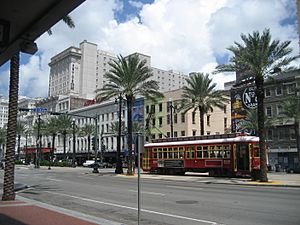
New Orleans has four active streetcar lines:
- The St. Charles Streetcar Line is the oldest continuously operating streetcar line in the U.S. The line first operated as local rail service in 1835 between Carrollton and downtown New Orleans. Operated by the Carrollton & New Orleans R.R. Co., the locomotives were then powered by steam engines, and a one-way fare cost 25 cents. Each car is a historic landmark. It runs from Canal Street to the other end of St. Charles Avenue, then turns right into South Carrollton Avenue to its terminal at Carrollton and Claiborne.
- The Riverfront Streetcar Line runs parallel to the river from Esplanade Street through the French Quarter to Canal Street to the Convention Center above Julia Street in the Arts District.
- The Canal Streetcar Line uses the Riverfront line tracks from the intersection of Canal Street and Poydras Street, down Canal Street, then branches off and ends at the cemeteries at City Park Avenue, with a spur running from the intersection of Canal and Carrollton Avenue to the entrance of City Park at Esplanade, near the entrance to the New Orleans Museum of Art.
- The Rampart–St. Claude Streetcar Line opened on January 28, 2013, as the Loyola-UPT Line running along Loyola Avenue from New Orleans Union Passenger Terminal to Canal Street, then continuing along Canal Street to the river, and on weekends on the Riverfront line tracks to French Market. The French Quarter Rail Expansion extended the line from the Loyola Avenue/Canal Street intersection along Rampart Street and St. Claude Avenue to Elysian Fields Avenue. It no longer runs along Canal Street to the river, or on weekends on the Riverfront line tracks to French Market.
The city's streetcars were featured in the Tennessee Williams play A Streetcar Named Desire. The streetcar line to Desire Street became a bus line in 1948.
Buses
Public transportation is operated by the New Orleans Regional Transit Authority ("RTA"). Many bus routes connect the city and suburban areas. The RTA lost 200+ buses in the flood. Some of the replacement buses operate on biodiesel. The Jefferson Parish Department of Transit Administration operates Jefferson Transit, which provides service between the city and its suburbs.
Ferries
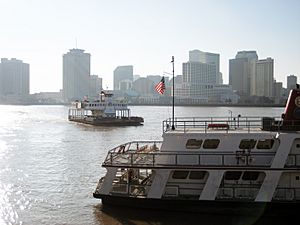
New Orleans has had continuous ferry service since 1827, operating three routes as of 2017. The Canal Street Ferry (or Algiers Ferry) connects downtown New Orleans at the foot of Canal Street with the National Historic Landmark District of Algiers Point across the Mississippi ("West Bank" in local parlance). It services passenger vehicles, bicycles and pedestrians. This same terminal also serves the Canal Street/Gretna Ferry, connecting Gretna, Louisiana for pedestrians and bicyclists only. A third auto/bicycle/pedestrian connects Chalmette, Louisiana and Lower Algiers.
Bicycling
The city's flat landscape, simple street grid and mild winters facilitate bicycle ridership, helping to make New Orleans eighth among U.S. cities in its rate of bicycle and pedestrian transportation as of 2010, and sixth in terms of the percentage of bicycling commuters. New Orleans is located at the start of the Mississippi River Trail, a 3,000-mile (4,800 km) bicycle path that stretches from the city's Audubon Park to Minnesota. Since Katrina the city has actively sought to promote bicycling by constructing a $1.5 million bike trail from Mid-City to Lake Pontchartrain, and by adding over 37 miles (60 km) of bicycle lanes to various streets, including St. Charles Avenue. In 2009, Tulane University contributed to these efforts by converting the main street through its Uptown campus, McAlister Place, into a pedestrian mall open to bicycle traffic. The Lafitte Greenway bicycle and pedestrian trail opened in 2015, and is ultimately planned to extend 3.1-mile (5.0 km) from the French Quarter to Lakeview. New Orleans has been recognized for its abundance of uniquely decorated and uniquely designed bicycles.
Roads
New Orleans is served by Interstate 10, Interstate 610 and Interstate 510. I-10 travels east–west through the city as the Pontchartrain Expressway. In New Orleans East it is known as the Eastern Expressway. I-610 provides a direct shortcut for traffic passing through New Orleans via I-10, allowing that traffic to bypass I-10's southward curve.
In addition to the interstates, U.S. 90 travels through the city, while U.S. 61 terminates downtown. In addition, U.S. 11 terminates in the eastern portion of the city.
New Orleans is home to many bridges; Crescent City Connection is perhaps the most notable. It serves as New Orleans' major bridge across the Mississippi, providing a connection between the city's downtown on the eastbank and its westbank suburbs. Other Mississippi crossings are the Huey P. Long Bridge, carrying U.S. 90 and the Hale Boggs Memorial Bridge, carrying Interstate 310.
The Twin Span Bridge, a five-mile (8 km) causeway in eastern New Orleans, carries I-10 across Lake Pontchartrain. Also in eastern New Orleans, Interstate 510/LA 47 travels across the Intracoastal Waterway/Mississippi River-Gulf Outlet Canal via the Paris Road Bridge, connecting New Orleans East and suburban Chalmette.
The tolled Lake Pontchartrain Causeway, consisting of two parallel bridges are, at 24 miles (39 km) long, the longest bridges in the world. Built in the 1950s (southbound span) and 1960s (northbound span), the bridges connect New Orleans with its suburbs on the north shore of Lake Pontchartrain via Metairie.
Taxi service
United Cab is the city's largest taxi service, with a fleet of over 300 cabs. It has operated 365 days a year since its establishment in 1938, with the exception of the month after Hurricane Katrina, in which operations were temporarily shut down due to disruptions in radio service.
United Cab's fleet was once larger than 450 cabs, but has been reduced in recent years due to competition from services like Uber and Lyft, according to owner Syed Kazmi. In January 2016, New Orleans-based sweet shop Sucré approached United Cab with to deliver its king cakes locally on-demand. Sucré saw this partnership as a way to alleviate some of the financial pressure being placed on taxi services due to Uber's presence in the city.
Airports
The metropolitan area is served by the Louis Armstrong New Orleans International Airport, located in the suburb of Kenner. Regional airports include the Lakefront Airport, Naval Air Station Joint Reserve Base New Orleans (Callender Field) in the suburb of Belle Chasse and Southern Seaplane Airport, also located in Belle Chasse. Southern Seaplane has a 3,200-foot (980 m) runway for wheeled planes and a 5,000-foot (1,500 m) water runway for seaplanes.
Armstrong International is the busiest airport in Louisiana and the only to handle scheduled international passenger flights. As of 2018, more than 13 million passengers passed through Armstrong, on nonstops flights from more than 57 destinations, including foreign nonstops from the United Kingdom, Germany, Canada, Mexico, Jamaica and the Dominican Republic.
Rail
The city is served by Amtrak. The New Orleans Union Passenger Terminal is the central rail depot and is served by the Crescent, operating between New Orleans and New York City; the City of New Orleans, operating between New Orleans and Chicago and the Sunset Limited, operating between New Orleans and Los Angeles. Up until August 2005 (when Hurricane Katrina struck), the Sunset Limited's route continued east to Orlando.
With the strategic benefits of both the port and its double-track Mississippi River crossings, the city attracted all six of the Class I railroads in North America: Union Pacific Railroad, BNSF Railway, Norfolk Southern Railway, Canadian Pacific Kansas City, CSX Transportation and Canadian National Railway. The New Orleans Public Belt Railroad provides interchange services between the railroads.
Modal characteristics
According to the 2016 American Community Survey, 67.4% of working city of New Orleans residents commuted by driving alone, 9.7% carpooled, 7.3% used public transportation, and 4.9% walked. About 5% used all other forms of transportation, including taxicab, motorcycle, and bicycle. About 5.7% of working New Orleans residents worked at home.
Many city of New Orleans households own no personal automobiles. In 2015, 18.8% of New Orleans households were without a car, which increased to 20.2% in 2016. The national average was 8.7 percent in 2016. New Orleans averaged 1.26 cars per household in 2016, compared to a national average of 1.8 per household.
New Orleans ranks high among cities in terms of the percentage of working residents who commute by walking or bicycling. In 2013, 5% of working people from New Orleans commuted by walking and 2.8% commuted by cycling. During the same period, New Orleans ranked thirteenth for percentage of workers who commuted by walking or biking among cities not included within the fifty most populous cities. Only nine of the most fifty most populous cities had a higher percentage of commuters who walked or biked than did New Orleans in 2013.
Notable people
Sister cities
Sister cities of New Orleans are:
 Cap-Haïtien, Haiti
Cap-Haïtien, Haiti Caracas, Venezuela
Caracas, Venezuela Durban, South Africa
Durban, South Africa Innsbruck, Austria
Innsbruck, Austria Isola del Liri, Italy
Isola del Liri, Italy Juan-les-Pins (Antibes), France
Juan-les-Pins (Antibes), France Maracaibo, Venezuela
Maracaibo, Venezuela Matsue, Japan
Matsue, Japan Mérida, Mexico
Mérida, Mexico Orléans, France
Orléans, France Pointe-Noire, Republic of the Congo
Pointe-Noire, Republic of the Congo San Miguel de Tucumán, Argentina
San Miguel de Tucumán, Argentina Tainan, Taiwan
Tainan, Taiwan Tegucigalpa, Honduras
Tegucigalpa, Honduras
See also
 In Spanish: Nueva Orleans para niños
In Spanish: Nueva Orleans para niños








